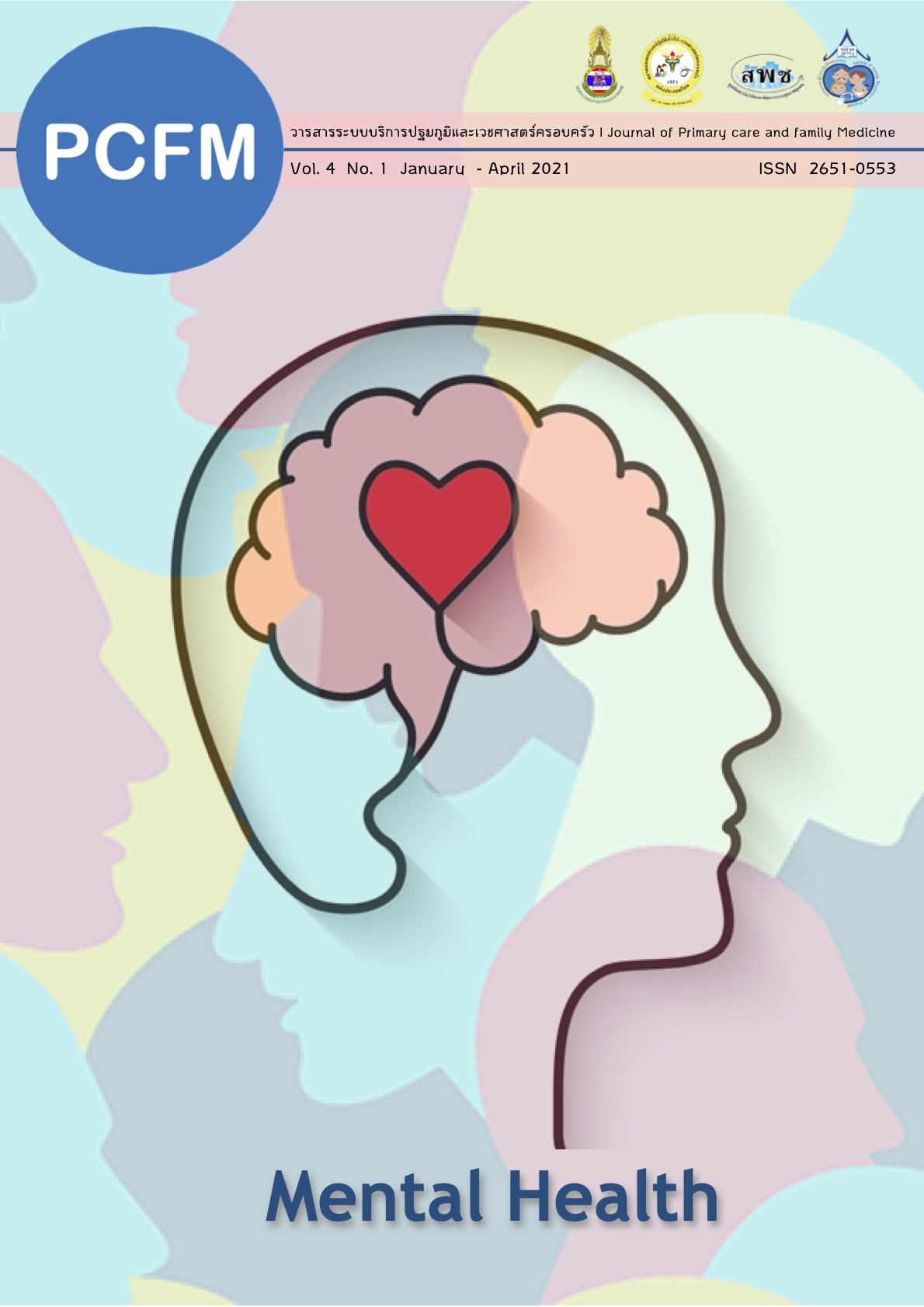Factors Associated with Successful Smoking Cessation in Smoking Cessation Clinic, Saraburi Hospital
Main Article Content
Abstract
Objective: This study aimed to evaluate factors associated with successful smoking cessation in the Smoking Cessation Clinic, Saraburi Hospital.
Design: Prognostic retrospective cohort study
Materials and Methods: Data were collected from medical records of the Smoking Cessation Clinic, Saraburi Hospital between 1 October 2018 to 31 June 2019. The follow-up period was one year, starting from the first visit. Participants were categorized into two groups which were successful or failed to quit smoking. The factors associated with successful smoking cessation were analyzed by multivariate logistic regression analysis (p-value < 0.05).
Results: Out of 158 participants, 22 participants succeeded in quitting smoking, and 136 failed. The study showed that the associated factors were receiving Nortriptyline with nitrate solution (Adjusted OR 5.37, 95% CI: 1.35-21.37, p-value 0.017) and mild to moderate nicotine dependence (Adjusted OR 11.62, 95% CI: 1.34-100.40, p-value 0.026) (Adjusted OR 9.14, 95% CI: 1.05-79.25, p-value 0.045), respectively.
Conclusion: Receiving Nortriptyline with nitrate solution and having mild to moderate nicotine dependence in smokers significantly resulted in an increased success rate of smoking cessation.
Article Details
The content and information in articles published in the PCFM journal are solely the opinions and responsibilities of the authors. The journal's editorial board does not necessarily agree with or share any responsibility for them.
All articles, information, content, images, etc., published in the PCFM journal are the copyright of the PCFM journal. If any individual or organization wishes to reproduce, distribute, or use any part or the entirety of the content, they must obtain written permission from the PCFM journal beforehand.
References
2. ผลกระทบของการสูบบุหรี่. สารานุกรมไทยสำหรับเยาวชนฯ [อินเทอร์เน็ต]. 2547[เข้าถึงเมื่อ 11 ก.พ. 2563]. เข้าถึงได้จาก: http://saranukromthai.or.th/sub/book/book.php?book=28&chap=6&page=t28-6-infodetail05.html
3. สถิติผู้เสียชีวิตจากบุหรี่. สำนักงานกองทุนสนับสนุนการสร้างเสริมสุขภาพ (สสส.) [อินเทอร์เน็ต]. 2557 [เข้าถึงเมื่อ 25 เม.ย.2563]. เข้าถึงได้จาก: http://www.nso.go.th/sites/2014/Pages/News/2561/N31-08-61-1.aspx
4. Tobacco. World Health Organization. [Internet]. 2019[cited 2020 Feb 12]. Available from: https://www.who.int/news-room/fact-sheets/detail/tobacco
5. El-Khoury Lesueur F, Bolze C, Melchior M. Factors associated with successful vs. unsuccessful smoking cessation: Data from a nationally representative study. Addict Behav. 2018 May 1;80:110–5.
6. พิรญาณ์ ปาสุวรรณ, เกรียงไกร กล้าประจันทร์, นิสากร สิงห์พูล, เสาวรินทร์ มีชูทรัพย์. ผลการให้คำปรึกษาร่วมกับการประยุกต์ใช้แบบแผนความเชื่อด้านสุขภาพที่มีผลต่อการรับรู้ด้านสุขภาพและพฤติกรรมการเลิกบุหรี่ คลินิกฟ้าใส โรงพยาบาลสระบุรี. 2559.
7. Hughes JR, Stead LF, Lancaster T. Notriptyline for smoking cessation: A review. Nicotine Tob Res. 2005;7(4):491–500.
8. Khairod P, Apichartkulchai S, Thavorncharoensap M. Efficacy of Varenicline and Nortriptyline in Smoking Cessation : Indirect Comparison of Randomized Controlled Trials. 2013;40(4):31–9.
9. Hoogendoorn M, Welsing P, Rutten-van Mölken MPMH. Cost-effectiveness of varenicline compared with bupropion, NRT, and nortriptyline for smoking cessation in the Netherlands. Curr Med Res Opin. 2008;24(1):51–61.
10. จิรบูรณ์ โตสงวน, ณธร ชัยญาคุณาพฤกษ์. การประเมินความคุ้มค่าและผลกระทบด้านงบประมานของมาตรการส่งเสริมการเลิกบุหรี่ในประเทศไทย. โครงการศึกษาเพื่อพัฒนาชุดสิทธิประโยชน์ภายใต้ระบบหลักประกันสุขภาพถ้วนหน้า. 2555.
11. อารยา ทองผิว, สุทัศน์ รุ่งเรืองหิรัญญา, สุรจิต สุนทรธรรม. คู่มือเวชปฏิบัติสำหรับการบำบัดโรคเสพยาสูบในผู้ป่วยโรคเรื้อรังในประเทศไทย ฉบับปรับปรุง พ.ศ.2561. พิมพ์ครั้งที่ 2. กรุงเทพฯ: ห้างหุ้นส่วนจำกัดสินทวีกิจ; 2561.
12. Hughes JR, Stead LF, Hartmann-Boyce J, Cahill K, Lancaster T. Antidepressants for smoking cessation. Cochrane Database Syst Rev. 2014;2014(1).
13. Nides M. Update on Pharmacologic Options for Smoking Cessation Treatment. Am J Med. 2008;121 (4 SUPPL.):20–31.
14. França SA de S, das Neves ALF, de Souza TAS, Martins NCN, Carneiro SR, Sarges E do SNF, et al. Factors associated with smoking cessation. Vol. 49, Revista de Saude Publica. Universidade de Sao Paulo; 2015.
15. Hymowitz N, Cummings KM, Hyland A, Lynn WR, Pechacek TF, Hartwell TD. Predictors of smoking cessation in a cohort of adult smokers followed for five years. Tob Control. 1997;6 Suppl 2.
16. Hagimoto A, Nakamura M, Morita T, Masui S, Oshima A. Smoking cessation patterns and predictors of quitting smoking among the Japanese general population: A 1-year follow-up study. Addiction. 2010;105(1):164–73.
17. Benowitz NL. Nicotine addiction [Internet]. Schwartz RS, editor. Vol. 362, New England Journal of Medicine. Massachussetts Medical Society; 2010 [cited 2020 Feb 15]. p. 2295. Available from: http://www.nejm.org/doi/10.1056/NEJMra0809890
18. Kim Y, Cho WK. Factors associated with successful smoking cessation in Korean adult males: Findings from a national survey. Iran J Public Health. 2014 Nov 9;43(11):1486–96.
19. Lee CW, Kahende J. Factors associated with successful smoking cessation in the United States, 2000. Am J Public Health. 2007 Jan 8;97(8):1503–9.
20. Jampaklay A, Borland R, Yong HH, Sirirassamee B, Fotuhi O, Fong GT. Predictors of successful quitting among Thai adult smokers: Evidence from ITC-SEA (Thailand) survey. Int J Environ Res Public Health. 2015 Sep 25;12(10):12095–109.
21. Li L, Borland R, Yong HH, Fong GT, Bansal-travers M, Quah ACK, et al. Predictors of smoking cessation among adult smokers in Malaysia and Thailand: Findings from the International Tobacco Control Southeast Asia survey. Nicotine Tob Res. 2010 Oct;12(SUPPL. 1):S34.
22. Li L, Feng G, Jiang Y, Yong HH, Borland R, Fong GT. Prospective predictors of quitting behaviours among adult smokers in six cities in China: Findings from the International Tobacco Control (ITC) China Survey. Addiction. 2011;106(7):1335–45.
23. Bacha ZA, Layoun N, Khayat G, Hallit S. Factors associated with smoking cessation success in Lebanon. Pharm Pract (Granada). 2018;16(1).
24. Siahpush M, Borland R, Scollo M. Factors associated with smoking cessation in a national sample of Australians. Nicotine Tob Res. 2003 Jul 1;5(4):597–602.


